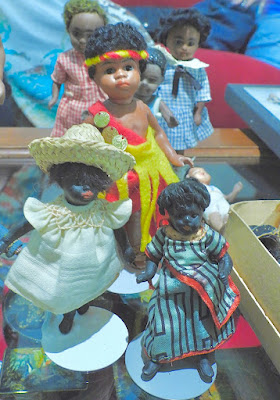Member Sharon Weintraub did a program on Black all-bisque dolls. She explained the French and German companies, and later Japanese makers, created Black all-bisque dolls, although in far smaller numbers than white dolls. While sometimes a Black all-bisque doll was made in same mold as a white doll and simply tinted brown, companies also created these dolls with ethnic features. In most cases the dolls were not made expressly for Black children. Many were garbed in ethnic costumes representing French or German colonies or were dressed as servants or entertainers. This example by Simon and Halbig is incised 836 and is a standard mold tinted with a brown complexion. She has bare feet and wears her original bathing costume. The diminutive doll she holds is a French doll known as a Liliputien. Just 2.75 inches high, she has a swivel neck with a molded loop and has peg-jointed arms and legs. These Les Liliputiens came in a wide variety of costumes; although the white versions generally wore painted light blue boots, the Black dolls were barefoot.
Sharon next discussed the Black all-bisque dolls by the German company Gebruder Kuhnlenz. She said the these dolls have appealing ethnic features with full lips and prominent lower faces. The complexions vary from brown to deep black, the dolls do not have painted lashes, and are barefoot. This pair in their original box wear the costumes of cakewalk dancers. Inside one of the sections in the box is written in pencil "From Grace to Sadie Newell Christmas 1889."
Three more dolls by Kuhnlenz. The red and yellow outfit is a copy of an original costume worn by a Black Kuhnlenz doll.
Sharon displayed these examples of Black all-bisque dolls attributed to the German company J.D. Kestner. The two girl dolls have swivel necks. The one in the red gingham dress has a closed mouth while the one in blue has an open mouth with tiny inset teeth. The standing boy in the molded rompers has loop-jointed arms. All of the dolls have bare feet.
This is a frozen version of the boy in the molded outfit.
Sharon said that the firm of Hertwig and Company made a wide variety of Black all-bisque dolls. The tallest doll in the "grass" skirt is painted bisque. Next to her is a tiny immobile figure of a Black man in a yellow top hat; he is part of a family of miniature Black figures. Behind him are two cute character dolls in their original matching ribbon outfits. In the back row are two more examples of German Black all-bisque does by unknown German companies. The one in the molded outfit and "straw" hat is wire-jointed. The doll next to him in a molded turban wears his original Middle-Eastern outfit.
Sharon then shared examples of French Black all-bisque dolls. The one in the red and white outfit is marked on the back of her swivel neck with the "F.G." in a scroll mark of Francois Gauthier. Her all-original outfit may represent one of France's Caribbean colonies. She was made using a typical all-bisque mignonnette doll mold and has molded boots. The two little dolls are more examples of Liliputiens and wear their original clothing.
Sharon explained that when German goods were embargoed during WWI, Japanese companies entered the bisque doll market, often directly copying German dolls. This example of a Japanese Black all-bisque doll may be early, because the modeling and decoration are of higher quality than is typically found on these Japanese products. The doll has unusual "snow" hair created with bits of ground bisque.
Member Bette Birdsong brought several examples of Black all-bisque dolls. This tiny bare-foot example is by Simon and Halbig.
These are more typical examples of Japanese dolls. They are often referred to as "Topsy" because of the tiny pigtails inserted into their scalps. Such dolls were often sold in five and dime stores in the United States. Copies of these dolls with extremely black shiny complexions began being produced in China in the 1980s.
A variety of itty-bitty Black babies ride in a tiny tin car. The one in red is an all-bisque doll and the other two are seated figurines (the one in the back is eating a watermelon slice). These seated figurines are often found attached to miniature cotton bales and were sold as souvenirs throughout the South.
Member Pam Hardy shared this black cloth doll with an embroidered face. It appears to be a commercially produced doll from the 1940s.
Member Jenell Howell brought these two tiny Liliputiens.
She also shared this stunning wooden Schoenhut doll.















